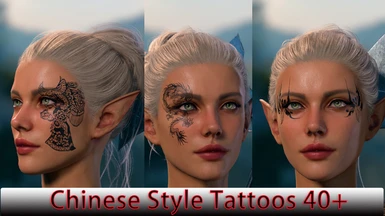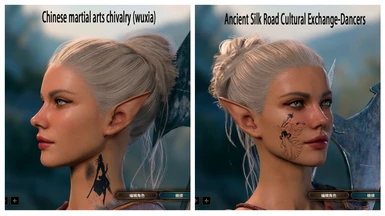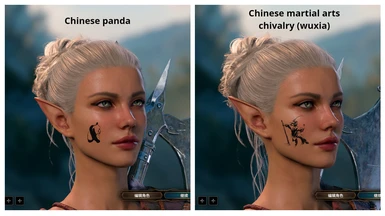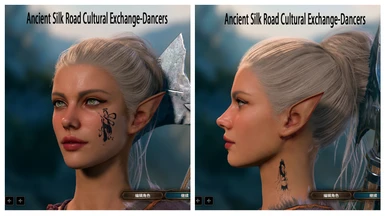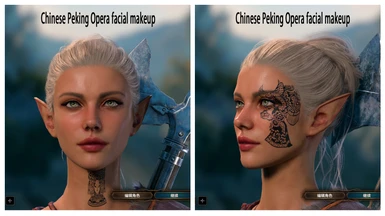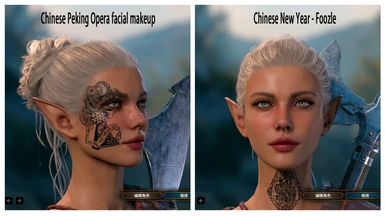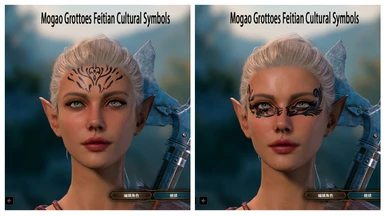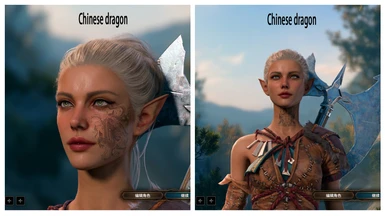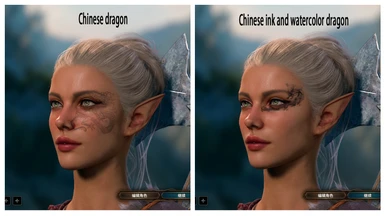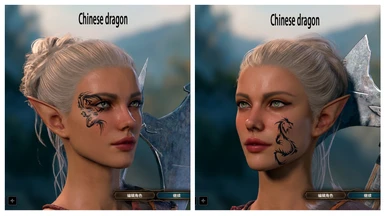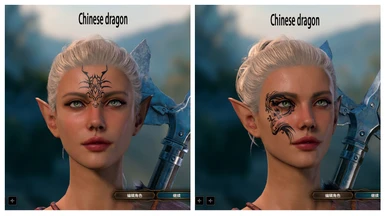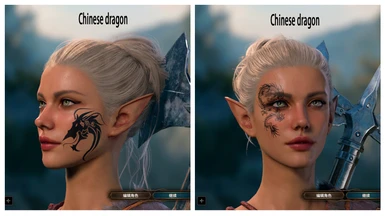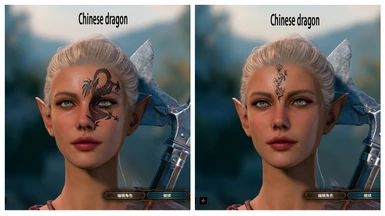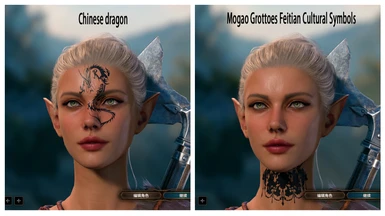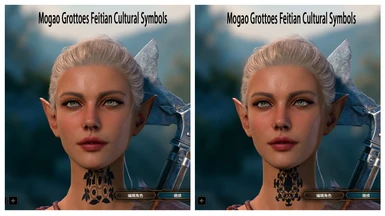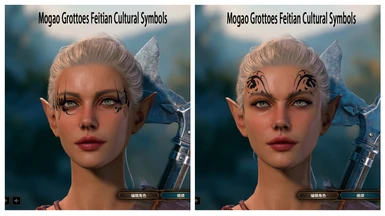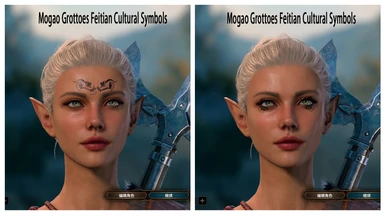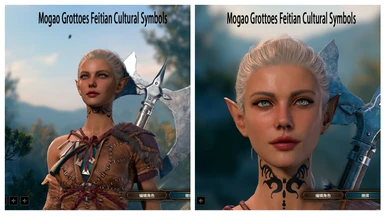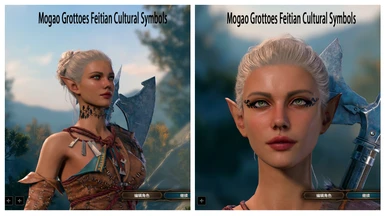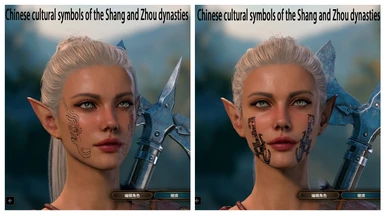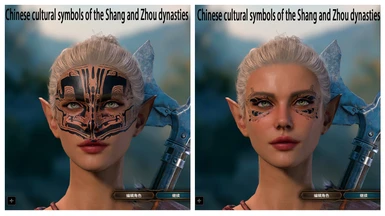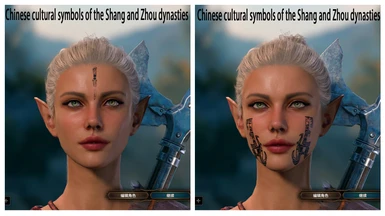About this mod
Here is a new set of facial tattoo , replacing all facial tattoo patterns with ones that are rich in Chinese cultural characteristics. I hope you will like them.More than 40 in all.
- Permissions and credits
- Changelogs
- Donations
All 40+ face tattoos have been fully replaced,enjoy it ☺
-----------------------------------------------------------------------------
Installation
1. Download my file.
2. Open .rar and drag/drop folder "Generated" folder into "Data" your game's directory, which is by default:
C:\Program Files (x86)\Steam\steamapps\common\Baldurs Gate 3\Data
So now you have:
C:\Program Files (x86)\Steam\steamapps\common\Baldurs Gate 3\Data\Generated
You should only have ONE Generated folder. With no Numbers or Letters, when you drag and drop folders they will merge together, or replace existing files if it's an update or different mod.
3. If you are prompted to "Replace files" - click "Yes", unless you are unsure what you are replacing, then make sure you don't have any other tattoo mods and/if you are okay with replacing them.
4. Have fun!~
Uninstallation
Steps are identical to Installation but in reverse. If you need to see which exact file and folder to delete - please refer to the "Preview file contents" under the file!
------------------------------------------------------------------------------
Chinese pandas
Chinese Panda, also known as Giant Panda, is one of the most beloved and iconic animals in the world. They are a national treasure of China and renowned for their adorable, gentle, and lovable appearance. Here are some introductions about Chinese Pandas:
Physical Characteristics: Chinese Pandas have round, chubby bodies, black and white fur, and black eye patches. They often present a clumsy yet endearing image with their large, round black eyes and round bellies.
Habitat: Chinese Pandas primarily inhabit bamboo forests and mountainous regions in China, such as Sichuan, Shaanxi, Gansu, and Yunnan provinces. They require abundant bamboo as food and habitat.
Dietary Habits: Pandas are herbivores and mainly feed on bamboo. They have a simple digestive system and consume a large amount of bamboo to obtain sufficient nutrition. Besides bamboo, they also eat some fruits, nuts, and other plants.
Conservation Status: Chinese Pandas are an endangered species and protected by the International Union for Conservation of Nature (IUCN). Due to habitat destruction, illegal hunting, and other human activities, panda populations have dramatically declined over the past few decades. The Chinese government has taken proactive conservation measures, including establishing nature reserves and implementing breeding programs, to assist in the recovery of panda populations.
International Cooperation: Chinese Pandas have also become ambassadors for international exchange and cooperation. China actively participates in international panda lending programs, loaning pandas to other countries for exhibition and research purposes. This not only promotes friendly exchanges between nations but also helps raise awareness for panda conservation.
Chinese Pandas represent the importance of biodiversity and call for environmental protection as a unique and precious species. They symbolize both Chinese culture and natural heritage and are one of the focal points for global biodiversity conservation.
Chinese dragons
The upcoming year of 2024 is the Year of the Dragon in the Chinese lunar calendar, so having a tattoo with dragon elements is definitely indispensable.
Chinese Dragon is regarded as a symbol of the Chinese nation and is an important element in Chinese culture and tradition. Here is some information about the Chinese Dragon:
Mythology and Symbolism: In traditional Chinese culture, the dragon is often portrayed as a mysterious, majestic, and powerful creature. It is believed to bring good luck, hold sacred significance, and possess protective qualities. The dragon symbolizes power, honor, wisdom, longevity, and prosperity in Chinese culture.
Physical Characteristics: The Chinese Dragon is typically depicted as a serpent-like creature with fish scales, bird claws, horns, and long whiskers. It can fly and swim, sometimes surrounded by phoenixes, jewels, or clouds.
History and Art: The Chinese Dragon has played a significant role in Chinese history, appearing in numerous legends, stories, and artworks. In traditional Chinese paintings, sculptures, costumes, and architecture, the dragon is often depicted as an elegant and solemn figure.
Cultural Celebrations: The Chinese people hold a high regard for dragons and incorporate them into many important festivals and celebrations. For example, dragon dance performances and dragon boat races during the Lunar New Year are integral parts of Chinese festivities.
The symbolism of the Chinese Dragon extends beyond borders, and it is widely recognized worldwide. The Chinese Dragon represents the spirit and cultural traditions of the Chinese people and is one of the prides of the Chinese nation.
Chinese Peking Opera
Peking Opera, also known as Beijing Opera, is one of the most famous and popular forms of traditional Chinese theater. It originated in Beijing and has a long history and rich cultural significance. Here is a brief introduction to Peking Opera:
Origin and Development:
Peking Opera originated in the late 18th and early 19th centuries in Beijing. It evolved from the fusion of four major regional opera styles: Hubei Xiangju, Henan Yuju, Shandong Bangzi, and Anhui Huangmei Opera. Peking Opera absorbed the characteristics of these various local opera styles and gradually formed its unique style through performances in the imperial court and folk traditions.
Performance Characteristics:
Peking Opera is renowned for its exquisite performing arts and diverse techniques. It emphasizes a combination of singing, recitation, acting, and acrobatics (known as "cheng" in Chinese). Performers use elaborate costumes, precise body movements, and distinctive facial makeup to portray characters' personalities and emotions. Additionally, Peking Opera pays attention to musical accompaniment and stage settings to create the atmosphere and context of the drama.
Repertoire and Storylines:
Peking Opera encompasses a wide range of plays, including historical dramas, adaptations from traditional literature, mythological legends, and literary classics. These plays depict various aspects of Chinese history, culture, and social life. The storylines often revolve around heroism, love, palace intrigues, and family conflicts, showcasing strong emotional elements and dramatic tension.
Cultural Heritage and International Influence:
Peking Opera is recognized as an intangible cultural heritage by UNESCO and is considered a national treasure of China. It enjoys widespread acclaim both within China and internationally, attracting numerous audiences and art enthusiasts. Peking Opera has also been showcased on international stages, introducing Chinese traditional culture and artistry to foreign audiences.
Peking Opera represents the pinnacle of traditional Chinese theater, with its unique performance style and profound cultural heritage. It serves as a precious cultural asset of China. Through the appreciation and study of Peking Opera, people can gain a deeper understanding of Chinese history, culture, and artistic traditions.
Dunhuang Mogao Grottoes culture
The Mogao Grottoes in Dunhuang, China, is an important site of Buddhist art renowned for its rich and diverse wall paintings. One of the most famous and unique images found there is the "Flying Celestial."
A Flying Celestial refers to the depiction of angelic or celestial figures dressed in splendid attire that appears to be soaring through the air. They are often portrayed in various poses on the wall paintings of the Mogao Grottoes, sometimes adorned with wings, flowing robes, and divine halos.
These Flying Celestials represent the human longing for spiritual freedom and transcending the material world. They convey the notion of transcending worldly desires as emphasized in Buddhist beliefs, while also showcasing the realm of spirituality and beauty.
The Flying Celestial images are widely depicted throughout the wall paintings of the Mogao Grottoes, with numerous variations in posture and appearance. They are considered masterpieces of Buddhist art, showcasing the imagination and skill of ancient artists.
The Flying Celestial wall paintings in the Mogao Grottoes hold not only cultural and artistic value but also serve as important resources for studying ancient Buddhist culture and history. They attract visitors and scholars from around the world who come to admire and research them.
Chinese Shang and Zhou Dynasties culture
The Shang and Zhou cultures in China encompass two significant periods in Chinese history. Here is a brief introduction to Chinese Shang and Zhou cultures:
Shang Dynasty Culture:
The Shang Dynasty (approximately 1600 BC - 1046 BC) was the first recorded dynasty in Chinese history, located in present-day Henan, Shaanxi, and Shandong provinces. The Shang culture is renowned for its bronze casting and the development of oracle bone script during the Shang period. Bronze objects were widely used for ritual and ceremonial purposes, reflecting the social hierarchy and religious beliefs of the time. Oracle bone script, inscribed on turtle shells or animal bones, is the earliest form of Chinese characters and records historical events, sacrificial rituals, and divination practices.
Western Zhou Dynasty Culture:
The Western Zhou Dynasty succeeded the Shang Dynasty, spanning from 1046 BC to 771 BC and centered in present-day Shaanxi and Henan regions. The Western Zhou culture continued the traditions of the Shang Dynasty but also exhibited some new characteristics. Feudalism was established, with lower aristocrats inheriting their social status and controlling land and people. Religious beliefs remained significant, and rituals and ceremonies played a vital role in societal life.
Social System and Philosophy:
The social system of Shang and Zhou cultures was based on feudalism, with the ruling monarchs and aristocratic class holding political and economic power. A clear hierarchical structure was in place, accompanied by strict ritual norms. Religion constituted one of the core values of the period, as people believed in the existence of deities between heaven and earth and sought blessings through sacrificial rituals.
Art and Literature:
Artistic and literary works of the Shang and Zhou periods reflected the aesthetic concepts and creative expression of the time. Bronze casting was considered the most important artistic form, adorned with exquisite patterns and designs. Additionally, the ancient book "Book of Songs" (Shi Jing) emerged as one of the earliest literary works in China, containing over 300 ancient folk songs and profound verses with deep meanings.
The Shang and Zhou cultures exerted a profound influence on the development of Chinese history and culture. They laid the foundation for the feudal society in China, inspired future dynasties, and left a lasting impact on art, literature, and religious customs.
Chinese martial arts culture(WuXia)
Chinese martial arts, also known as Wuxia, is a unique cultural phenomenon that stems from ancient Chinese martial traditions and the Jianghu (martial world) culture. It holds a significant position in Chinese literature, film, and other art forms, with far-reaching influence both domestically and internationally. Here is a brief introduction to Chinese martial arts:
Origin and Development:
Chinese martial arts originated from the ancient martial arts culture of China, particularly the swordplay and knife techniques of the Song Dynasty. Martial arts novels can be traced back to the Ming Dynasty, reaching its zenith during the Qing Dynasty. Martial arts works portray adventures of highly skilled martial artists in their quest for justice and righteousness in the Jianghu.
Themes and Characteristics:
The themes of martial arts works often revolve around martial arts skills, martial brotherhood, heroic figures, and romance. They are characterized by exquisite martial arts movements, intense confrontations, and gripping plots. Protagonists in martial arts novels and films are often skilled warriors who possess extraordinary martial abilities, uprightness, bravery, and unique charm.
Influence and Heritage:
Chinese martial arts culture has had profound influence on the Chinese people, becoming an important subject in domestic literature, film, and other art forms. Renowned martial arts novelists such as Jin Yong, Gu Long, and Liang Yusheng have left behind many classic works. Chinese martial arts have also gained international popularity, attracting readers and audiences from around the world.
Martial Arts and Real Life:
Although martial arts works often contain fictional elements, they also reflect certain aspects of traditional Chinese culture and values. Themes of loyalty, chivalry, justice, and moral principles are common in martial arts works. Martial arts culture has shaped to some extent the mindset and behavioral norms of the Chinese people.
In conclusion, Chinese martial arts, or Wuxia, is a culturally captivating and influential phenomenon. It represents the essence of traditional Chinese martial arts and Jianghu culture, showcasing the courage, righteousness, and romantic heroism of its characters. Through the appreciation and understanding of Chinese martial arts, people can gain a better insight into Chinese culture and values.
The quintessential Chinese kung fu superstar, Jackie Chan, Jet Li.Wu Jing, Donnie Yen.
Silk Road culture
The Silk Road is an ancient trade network that connected the East and West, facilitating the exchange of goods, culture, and knowledge. On the other hand, the Belt and Road Initiative (BRI) is a modern development strategy proposed by China, aiming to strengthen economic connections and cooperation between Asia, Europe, and Africa. Here's an overview of the connection between the Silk Road and the Belt and Road Initiative:
Economic Connectivity: The Silk Road served as a trade route, linking various countries and regions through both land and maritime transportation. The BRI also seeks to enhance global trade and economic cooperation by developing infrastructure and promoting trade facilitation to stimulate the economic growth of participating countries along the routes.
Geographic Extension: The Silk Road primarily involved the Eurasian continent, including China, Central Asia, the Middle East, and Europe. The BRI expands on the concept of the Silk Road, covering a broader geographical scope, encompassing countries and regions in Asia, Europe, Africa, and some parts of the Americas.
Cultural Exchange: The Silk Road was not only a bridge for commodity trade but also facilitated the diffusion of various cultures, religions, and knowledge. The BRI also emphasizes cultural exchanges and people-to-people interactions to foster friendship and understanding among different countries and regions.
Infrastructure Development: The BRI places significant emphasis on infrastructure construction, such as investments and cooperation in areas like highways, railways, ports, energy, and telecommunications. This infrastructure development will enhance connectivity among countries and regions along the Silk Road, promoting trade and economic development.
In conclusion, the Silk Road is an ancient trade network, while the Belt and Road Initiative is China's modern development strategy. They share similar goals of promoting trade, economic cooperation, and cultural exchange. However, the BRI places greater emphasis on global cooperation and infrastructure development, expanding the concept of the Silk Road and extending it to a wider geographical scope.
Special thanks
First, I would like to express my gratitude to CovenElf for creating the "CovenElf's Tattoo and Makeup Collection" (v1.2 Update). This mod has provided me with a lot of inspiration.
Next, I want to thank ArtByMari for creating the Tattoo tutorial. This tutorial has been very helpful to me.










